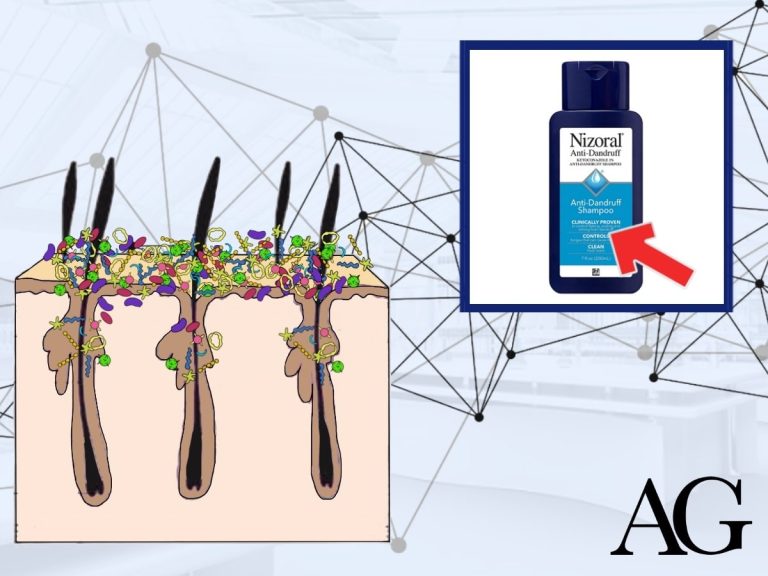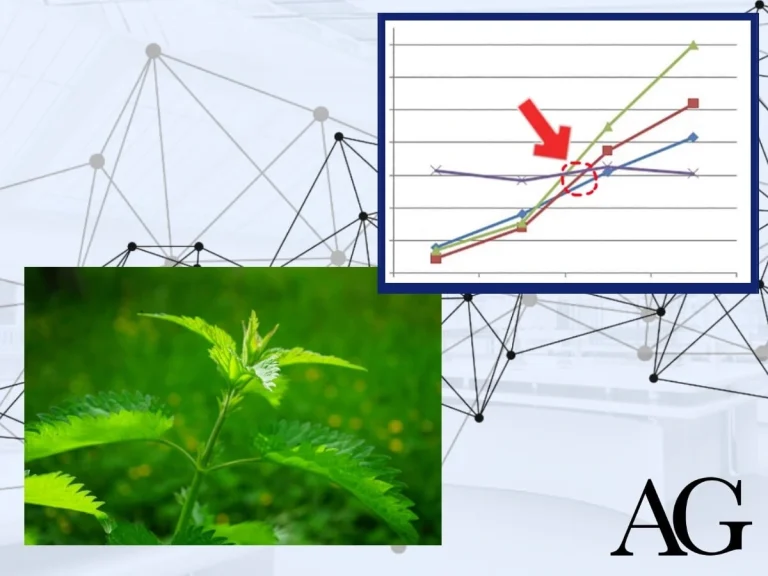It was a sunny day in 2018 and hairs were falling from my scalp like leaves fall from trees on a windy autumn day. To make matters worse, my hair shedding was accompanied by unforgivingly visible hair thinning. I could see my own scalp in the mirror! What the f**k. I absolutely refused to loose this battle against hair loss.
Some quick Googling let me know that, allegedly, green tea is a DHT blocker (DHT is a driver of pattern baldness). I started drinking bucket loads of green tea in hopes of restoring my hair.
While green tea has number of health benefits, including some benefits which support hair health, it was not green tea that helped me slaughter the monster that is hair loss.
In this article, we’ll cover:
- What is green tea?
- How does green tea improve hair growth?
- Is green tea for hair growth even worth your time?
- Topical versus oral green tea
What is green tea?
Green tea extract is an natural ingredient included in many shampoos, lotions and supplements marketed for hair loss. It is touted as a natural ingredient that can help you combat hair loss. But what actually is green tea?
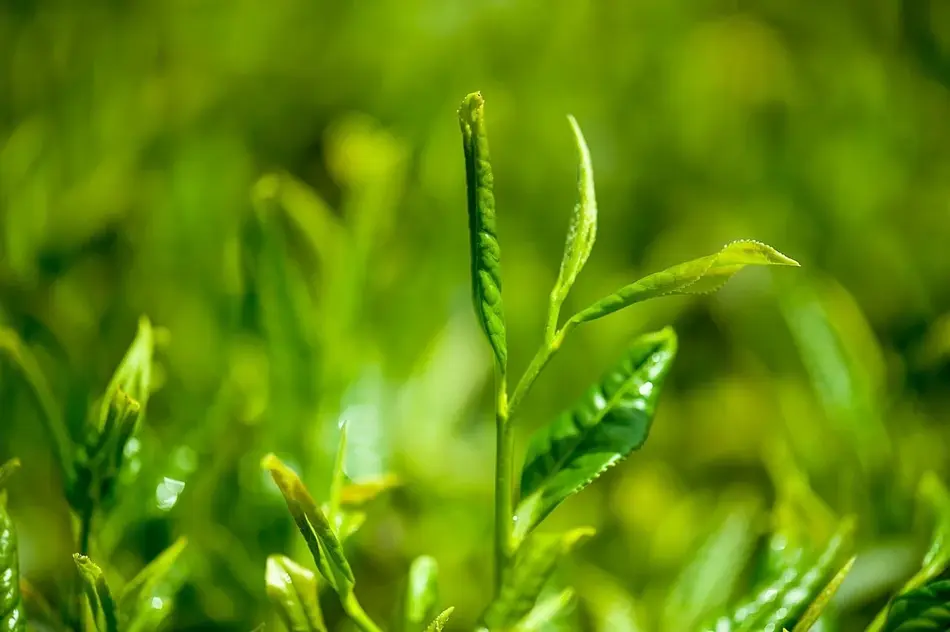
Green tea is a type of tea made from the leaves of the Camellia Sinensis plant. It is known for its potential health benefits, including high levels of antioxidants called catechins, which may help prevent cell damage, aid metabolism, lower inflammation and support overall well-being.
How does green tea influence hair growth?
1. 5ɑ-reductase inhibition
It is common wisdom in the hair loss industry that testosterone gets converted into dihydrotestosterone (DHT) by an enzyme called 5ɑ-reductase. Since DHT is a main driver of pattern baldness, blocking DHT through 5ɑ-reductase inhibitors such as Finasteride or Dutasteride can help stop and even partially reverse hair loss.

5ɑ-reductase comes in various forms and these can be found in different quantities around the body. Type 1 5ɑ-reductase is widely distributed around the body, including the skin and liver. This type of 5AR plays a less significant role on hair loss. On the other hand, type 2 5ɑ-reductase can concentrate in the hair follicles and has a much higher association with androgen-driven hair thinning.
The most potent polyphenol in green tea, epigallocatechin-3-gallate (EGCG) has been shown to inhibit type 1 5ɑ-reductase activity in a test tube study. However, its effect on type 2 5ɑ-reductase inhibition is much weaker1. For reference, finasteride is predominantly a type 2 5ɑ-reductase inhibitor.
This doesn’t mean EGCG is doesn’t help block any of DHT ghastly hair loss effects. Here’s why:
Topical EGCG has also been shown in laboratory settings to down-regulate the testosterone induced expression of androgen receptors2. This matters because at the end of the day, you could have all the DHT in the world, but DHT only induces hair loss when it binds to the androgen receptor.
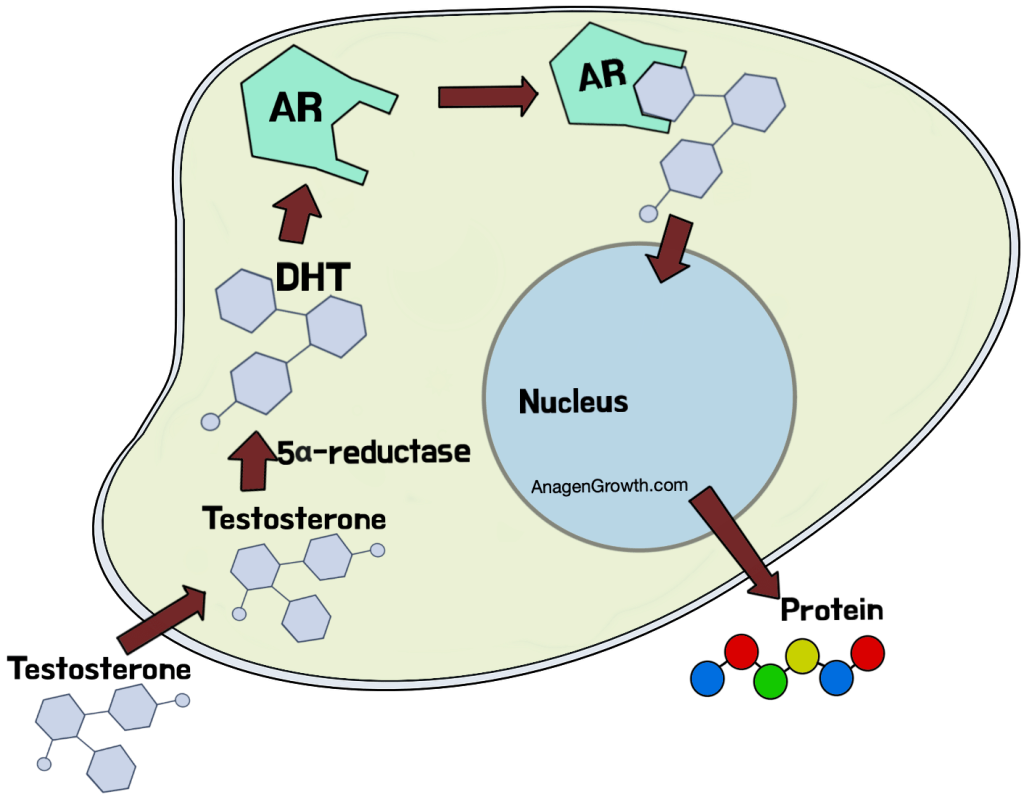
This is why people with Androgen Insensitivity Syndrome (AIS) have normal levels of DHT yet appear to be immune to pattern hair loss, since they have absent or faulty androgen receptors.

Okay, so green tea may help preserve hair health by lessening the effects of DHT. But, keep in mind that green tea is a weak DHT blocker and will likely produce very underwhelming results when consumed by itself.
2. Extended anagen (growth) phase
Hair grows in a repetitive cycle of growth, rest and shedding before returning to the growth (also known as anagen) phase. The longer the anagen phase and the greater the proportion of hair follicles in the anagen phase at any given time, the fuller your scalp will look and feel.
Green tea extends the anagen phase of the hair cycle3.
This is likely for a number of reasons. Green tea is rich in polyphenols and cachetins (plant based antioxidants). One of the major constituents of green tea polyphenols is EGCG.
EGCG can help extend the anagen phase by4:
- Up-regulating several miRNAs involved in hair cycle regulation
- Down-regulating mi-RNAs that obstruct the hair cycle and lead to cell death
- Decreasing oxidative stress
Furthermore, green tea contains caffeine. Caffeine, when applied topically can also help prolong the anagen phase of the hair cycle. Caffeine achieves this by suppressing phosphodiesterase which in turn up-regulates Insulin-like Growth Factor 1 (IGF-1).
IGF-1 signalling is an important regulator in hair follicle biology. Hair dermal papillae cells secrete significantly less IGF-1 than their counterparts from non-balding scalp follicles.
3. Lower sebum production and inflammation
Green tea extract can counteract excessive sebum production. Excessive sebum production can be problematic as this can lead to an overpopulation of certain strains of yeast and bacteria such as Malassezia and P.acnes. These microorganisms, when present in large quantities, can lead to inflammation and reduced scalp health which can in turn damage har follicle cycling and keratinocyte proliferation.
We have a whole article dedicated to this here.
4. Improved microcirculation
Balding scalps have 2.6 times less blood flow and 40% less oxygenation than non-balding scalps5, 6.

This study showed that the polyphenols from green tea can improve blood circulation and oxygenation to the skin. Note that the green tea is a MUCH weaker vasodilator than drugs like minoxidil.
5. Reduced stress
Bouts of severe mental or physical stress can cause or exacerbate hair shedding disorders like telogen effluvium. Yes, stress can cause hair loss. You can read our article about the link between stress and hair loss.
Another component of green tea is l-theanine. In 2019, a study provided healthy adults with 200mg of L-theanine on a daily basis for 4 weeks. The results showed that compared to the placebo group, subjects taking the L-theanine supplement reported lower levels of stress as well as improved sleep quality.
Considering that an average 200ml cup of green tea contains 7.9±3.8mg of l-theanine, you would need to consume around 25 cups of green tea per day to ingest as 200mg of l-theanine (clinically proven dose).
That’s a lot of tea. And not recommend since absurd amounts of green tea can lead to liver damage.
If you do want to give L-theanine try, you may drink tea (green or black) for a gentle dose. Alternatively, there are supplements that can provide a stronger dose (serving size is typically 200mg).
Another ingredient of green tea is GABA. In layman’s terms, when GABA interacts with a neuron, it makes it harder for the neuron to fire, thus reducing overall neuronal activity and essentially calming the nervous system. This results in a calming effect and can help regulate anxiety.
Therefore, GABA helps to reduce anxiety, promote relaxation, and contribute to a sense of tranquility. It’s a bit like reducing the static on the radio (radios? What are those?).
6. Anti-fibrotic properties
Green tea polyphenols also improve our ability to stimulate collagen and elastin production7.
It is well established that as pattern baldness progresses, the settlement of scar tissue (disorganised strands of collagen) increases in the scalp. Physically stimulating hair growth protocols such as microneedling can help reverse fibrosis by breaking down fibrosis and replacing it with aligned cross-hatching of collagen. By increasing our ability for tissue-remodelling, these therapies may become more effective.
Clinical trial data
Study 1
This study investigated the efficacy of a supplement containing green tea extract, omega 3 and 6 fatty acids, cholecalciferol, melatonin, beta-sitosterol, and soy isoflavones on 10 patients with androgenic alopecia.
All 10 subjects took 2 tablets of this supplement for 24 weeks. At the end of the study, patients saw a mean increase in hair count of 5.9% and a hair mass index increase of 9.5%.
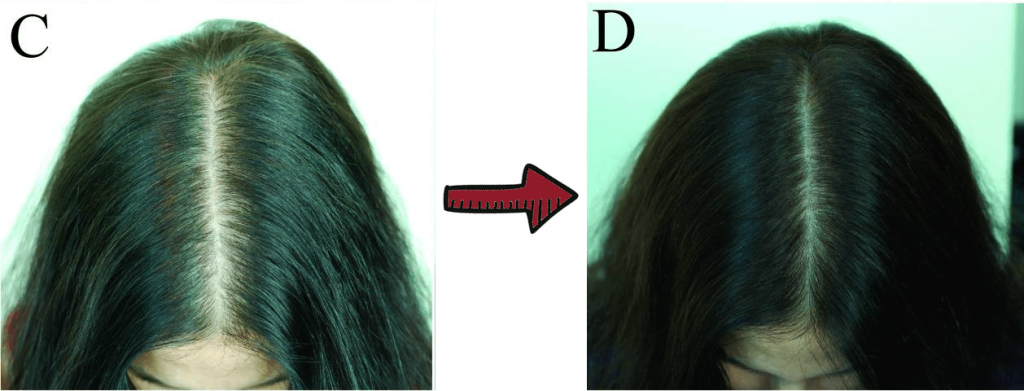
Unfortunately, since this supplement also contained compounds other than green tea extract, it is impossible to determine how much of the hair growth improvements can be attributed to the green tea extract.
Study 2
While not a study on green tea per se, this study administered 2 men with androgen alopecia with a concoction of ℽ-linoleic acid, ꞵ-sitosterol, EGCG, and genistein to be taken both orally and topically for 270 days.
The results are nothing short of incredible.
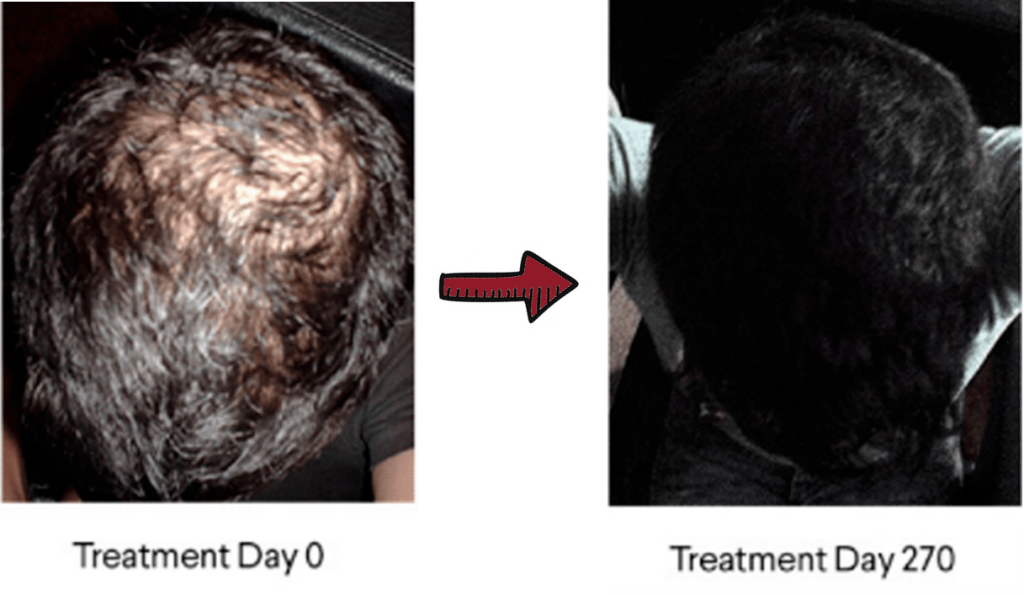
Sample size of only 2 people means that we cannot draw meaningful conclusions that can be applied to the broader public. Furthermore, since this supplement does not only contain, EGCG, these results cannot be translated to green tea extract supplements. Especially considering ℽ-linoleic is a DHT blocker.
Other studies
Other studies such as this, this and this have analysed the efficacy of green tea for hair growth in rat and test tube settings. The results are generally favourable and show positive hair growth properties.
Oral consumption vs topical application
Topical application
By using a lotion or serum with green tea extract directly on the scalp, we can target the hair follicles directly for a faster, more direct approach.
A problem here is how much of the lotion will permeate through the scalp and reach the follicle? Make sure to leave in for a while and don’t wash away..otherwise its useless.
Microneedling has a wide variety of benefits. One of them is that it can improve the absorption of topical lotions.
Naturally, not all topically applied compounds will permeate through the scalp and reach the hair follicle as easily as each other. Factors such as molecular weight, solubility, and chemical structure will influence the compounds ability to be absorbed through the skin.
While some ingredients such as propylene glycol permeate the scalp with relative ease, EGCG is a non-polar compound that is not soluble in water. Because of this, ECGC typically remains on the putter layer of the skin.
For this reason, microneedling may be especially beneficial in the case of topically applied green tea.
Oral application
There is no question that oral green tea has a wide host of general health benefits. Since drinking green tea or taking a green tea extract does not directly target the hair follicle son the scalp, it is very unlikely that oral green tea will have any cosmetically perceptible effects on hair growth.
Summary
Ultimately, green tea for hair loss is not a good standalone intervention. The data to support green tea for sustained hair health simply is not there. However, green tea does have some benefits you may want to take advantage of alongside your main hair regrowth protocol.
Problems with green tea for hair loss:
- Weak 5ɑ-reductase inhibitor (and only demonstrated in test tube studies)
- EGCG does not absorb easily
- Low chemical stability of green tea extracts can result in degradation when exposed to light, heat and oxygen. This will reduce their effectiveness. For this reason, getting a high quality product matters. You will also have to consider how you choose to store your green tea extract serums or drinks.
- A major limit in the exploitation of green tea and GTP benefits in nutraceutical and cosmetic fields is their low bioavailability, which led studies to develop alternative administration routes and formulations, such as hydrogels or nanoparticles.
Benefits of green tea for hair loss:
- No side effects when consuming under 8 cups per day.
- Green tea extract may directly and indirectly support hair health.

